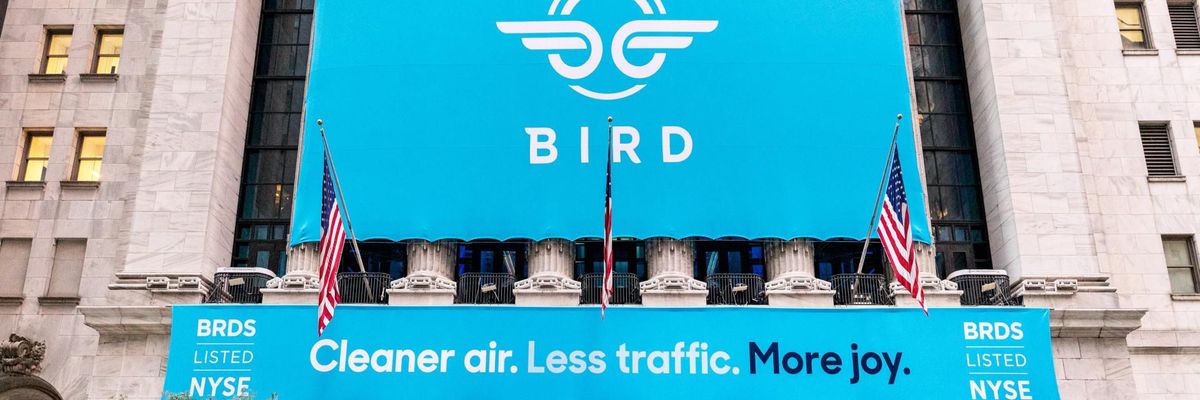

Get in the KNOW
on LA Startups & Tech
X
Image courtesy of the NYSE
What Does Bird’s Revenue Snafu Mean for the Future of Micromobility?
Maylin Tu
Maylin Tu is a freelance writer who lives in L.A. She writes about scooters, bikes and micro-mobility. Find her hovering by the cheese at your next local tech mixer.
In the beginning, there was Bird.
When Travis VanderZanden and company dropped the first Xiaomi scooters on the streets of Santa Monica, a micromobility revolution was born. But five years later, the shared micromobility startup’s future is in question.
Last month, Bird announced it overstated revenues for the last 2.5 years and may not have enough cash to survive, setting off waves of speculation about the viability of the industry. According to an SEC filing, the discrepancy was the result of counting rides taken by customers with an insufficient wallet balance as revenue.
This means that riders bilked the company out of millions of dollars. In an investor call, CFO Ben Lu said that Bird planned to revise numbers for the first two quarters of this year by $12.5 million for a total revision of $31.6 million from 2020 to 2022.
It was the latest in a spate of bad news for the company that went public via SPAC in 2021. In just the past year, Bird has also pulled out of multiple cities, changed CEOs and risked being delisted on the New York Stock Exchange. The revenue snafu seems to have further deflated optimism in the company, and the timing — as the economy reels from inflation and effects of the pandemic slowdown — couldn’t be worse.
“I was very surprised that it's $12.5 million. It's a large number,” said Prabin Joel Jones, ex-CTO of Bond Mobility and founder of Freshkart, a Belgium-based meal delivery startup. “But I'm also surprised that there's not a lot of people talking about it.”
How Did Bird Veer Off Course?
Critics, competitors and Bird itself have blamed multiple factors for the state of e-scooter startups, including a strategy of expansion at all costs, bloated general and administrative expenses and over- and under-regulation by cities.
“[Burning cash to expand] is okay at the beginning, but it cannot be the game for a really long time, when you absolutely have to find the right business model for you to be profitable,” said Jones.
Bird has made significant cuts in recent months, laying off 23% of its staff, halting product lines and slowing down the purchase of new scooters.
“Last quarter was, from a net-loss perspective, one of their best quarters. But it's too late. They should've done this a year ago,” Jones added.
Bird, Spin and others blame cities for over-regulating e-scooters, enforcing riding and parking restrictions — like speed limits, curfews and parking corrals — that disproportionately affect shared bikes and scooters. At the same time, they say municipalities have been too lax, allowing markets to be oversaturated by operators, making it impossible to achieve profitability. Emil Nnani, founder and CEO of Dallas-based micromobility startup Boaz Bikes, said that’s not a fair assessment.
“They're using the excuse of saying, ‘Hey, well, [there are] too many operators.’ But what that really says is… ‘Hey, we want to operate a horrible business, and we want to make money on it.’”
Nnani also pointed out that Bird is one of the last to adopt swappable batteries, which would allow it to cut down on operating costs; depleted scooters would no longer need to be transported to a home or warehouse for charging. Instead, batteries could simply be swapped in the field.
“They definitely have to raise a massive amount of funding in the next, say, three months. If they don't, it's going to be very difficult for them,” said Jones.
An Unlikely Scooter Suitor
As Bird rethinks its future, Helbiz CEO Salvatore Palella has been teasing a possible acquisition, one bird meme at a time.
\u201cI\u2019m starving\u201d— Salvatore Palella (@Salvatore Palella) 1670347315
The New York-based company is the only other e-scooter startup to go public. It recently acquired West Hollywood-based Wheels.
“Part of our short term and long term strategy is acquisitions within the micromobility space,” Amy Shat, chief people officer at Helbiz, told dot.LA. “Will we consider all opportunities we have to do that? Absolutely.”
Bird spokesperson Campbell Millum wouldn’t comment directly on the possibility of a sale. “We don't comment on rumors,” she wrote by email.
But Helbiz has its own problems. The company is currently trading at $0.16 and risks being delisted on Nasdaq.
Canary In the Coal Mine or Just Growing Pains?
Despite these setbacks, some industry insiders and companies say they are still bullish on shared micromobility.
For one, cities may be rethinking the nature of public-private partnerships in the sector — moving past the “battle royale” pilot stage where a large number of young companies fought for dominance on city streets and into something more sustainable, where cities pick the best companies and award them with more lucrative contracts.
For example, Santa Monica will be recruiting two operators for a three- to five- year term starting next year. Currently, Spin, Veo and Wheels are the only three operators in the city — Bird was unceremoniously booted last summer.
The future of shared micromobility might be partially subsidized, especially if cities want to make micromobility an integrated part of their transportation networks and an equitable option for all.
In cities like L.A., e-scooter companies are required to operate in low-income areas that are less lucrative for them. But in the future, cities might start subsidizing these rides.
“Nobody in the history of cities has figured out a way to really make money providing transportation as a public good,” said Colin Murphy, director of research and consulting at the Shared-Use Mobility Center, in an email.
Murphy argues the government routinely subsidizes the auto industry by building and repairing roads and setting aside public space for private vehicles.
“The same thing will have to happen with shared bikes and scooters if they're going to remain a real part of the transportation ecosystem,” he said.
That said, Boaz Bikes’ Nnani predicts that 2023 and 2024 will be “golden years” for shared micromobility. As bigger companies like Bird are forced to pull back, he said, smaller companies like his will have the space to grow.
“And sometime in 2025, I expect fresh money to start getting pumped into the industry, once they see that, ‘Hey, okay, everybody's figured out the unit economics’,” he said.
From Your Site Articles
- Wheels Pulls Out of Culver City and West Hollywood ›
- Bird Burns $43.7 million in Q2 as Revenue Rebounds 477% From Pandemic Plunge ›
- Bird Stock Tanks After Company Warns of Dwindling Cash Flow ›
- Why Cities Will Tailor Their Infrastructure To Micromobility - dot.LA ›
- E-Scooters Could Be The Future Of Micromobility In LA - dot.LA ›
Related Articles Around the Web
Maylin Tu
Maylin Tu is a freelance writer who lives in L.A. She writes about scooters, bikes and micro-mobility. Find her hovering by the cheese at your next local tech mixer.
Mitu Co-Founder Launches Fintech Company Aimed at Latinos
03:04 PM | October 29, 2020
After seeing the pandemic's disproportionate impact on lower-income minorities, Beatriz Acevedo, the co-founder of digital media company mitú, felt compelled to return to the startup world.
On Thursday, the L.A.-based entrepreneur and three-time Emmy-winning producer announced the launch of SUMA Wealth, a fintech company that will seek to provide U.S-born Latinos with financial-inclusion tools and resources.
In 2012, Acevedo launched her L.A.-based digital media company, which is oriented toward Latino youth. It raised over $50 million and boasts a monthly audience of nearly 100 million users. In 2018, Acevedo stepped down as president, and mitú was acquired this year by GoDigital Media Group for an undisclosed amount.
Acevedo will be applying much of the playbook that she used to grow mitú into what is arguably the leading digital media brand among Latino youth to her new venture.
"What mitú did was touch this audience that felt nobody saw them, and nobody got them," she told dot.LA. "That's what I plan to do with SUMA."

L.A.-based entrepreneur and three-time Emmy-winning producer Beatriz Acevedo is the co-founder of SUMA Wealth
SUMA sought a $500,000 pre-seed round but has more than doubled that. The round remains open.
Every funder in SUMA's round is female; most of them are Latina. At a panel on diversity hosted this week by dot.LA, Acevedo noted that her investors were easier to work with than the more traditional set of white male venture capitalists.
The pre-seed round was led by Chingona Ventures, with participation from The Fund, 2045 Ventures, Vitalize VC, Portfolia Rising America, Backstage Capital and OVO Fund, among others.
"I didn't have to explain to any of them why SUMA was important for our community," she said. "All of them come from that same background: where we grow up not talking about money, not talking about investment, being very confused. No matter if you went to an Ivy League school or you are somebody that did not go to college, we're all in the same boat. So it was very personal to them and they fully understood the problem."
In addition to a personal connection, the Latino community also represents a big economic market.
A 2020 study from the Latino Donor Collaborative, for instance, found that if Latinos living in the U.S. were considered a country, it would have the eighth-highest GDP in the world – larger than South Korea, Italy or Brazil.
It's also a rapidly growing segment: from 2010 to 2018, the group's GDP expanded 21% faster than India's and 30% faster than China's, according to the study.
Acevedo emphasized that SUMA is targeting U.S.-born Latinos, a group that she says has felt as if it doesn't quite belong.
Marketers tend to lump this U.S.-born Latino sector either into a general, English-speaking audience or a more traditional, Spanish-speaking group, Acevedo said.
By contrast, what mitú did and what SUMA plans to do is focus on the nuances that make this segment unique.
"The secret sauce (at mitú) was everything that we did was in-culture," she said. "It's nothing special that I did, but see them."
Acevedo said that rather than building a product and hoping to attract users to it, SUMA will start by building a brand that conveys it is "by Latinos for Latinos."
For example, the chupacabra – a mythical beast prominent in Latino folklore – is reprised on SUMA as the money-sucking "chupalana," which accompanies instructional content on topics like lowering debt, budgeting, taxes, investing and deciding whether to buy or lease.
The platform also aims to tap into what Acevedo describes as a different financial ethos. In contrast to the American reverence for self-reliance, for instance, she says, "my mother will tell you she has no money to save and invest, but if it was for someone in her family, she'd give all the money in the world. We're taking those nuances into account."
Acevedo believes developing trust among her target market is a key component to SUMA's brand. She says many Latinos harbor a deep-seated skepticism of traditional financial institutions, in large part due to a history of currency devaluations by Latin American governments that wiped out people's savings without warning.
"There's post-traumatic stress," Acevedo says, which has carried forward into today's younger generations.
Data from SUMA's 30-day beta period suggest this hypothesis has some merit. Acevedo said the company saw engagement rates 20-times higher than a composite benchmark of fintech company engagement rates. And the top questions SUMA has gotten from its users have centered around which institutions are trustworthy.
"They're hungry for this information and [they want] to do better, but they're incredibly confused on how to do it," Acevedo said.
"There are lots of Latino-led and -driven fintech offerings," she added, "but nobody has really built it at scale. I hope to build that."
SUMA is co-founded by Xavier Gutiérrez, president and CEO of the Arizona Coyotes hockey team – the first Latino to lead an NHL franchise.
"The economic success of the United States and its recovery from the current pandemic rely on the economic empowerment of this community. We exist to provide that empowerment," he said in a statement.
---
Sam Blake primarily covers entertainment and media for dot.LA. Find him on Twitter @hisamblake and email him at samblake@dot.LA
From Your Site Articles
- Beatriz Acevedo, President, Acevedo Foundation; Co-founder, LA ... ›
- Why Funding Inequity Isn't Deterring These Female Founders, VCs ... ›
- How Working From Home Challenges Women and How To Succeed ... ›
- Suma Raises $2 Million to Help Latinos Manage their Money - dot.LA ›
- Tala Raises $145 Million to Expand Its Financial Services - dot.LA ›
- Latino Entrepreneurs Account for 2% of all Venture Funding - dot.LA ›
- BayaniPay Becomes a Neo-Bank With East West Bank - dot.LA ›
Related Articles Around the Web
Read moreShow less
Sam Blake
Sam primarily covers entertainment and media for dot.LA. Previously he was Marjorie Deane Fellow at The Economist, where he wrote for the business and finance sections of the print edition. He has also worked at the XPRIZE Foundation, U.S. Government Accountability Office, KCRW, and MLB Advanced Media (now Disney Streaming Services). He holds an MBA from UCLA Anderson, an MPP from UCLA Luskin and a BA in History from University of Michigan. Email him at samblake@dot.LA and find him on Twitter @hisamblake
https://twitter.com/hisamblake
samblake@dot.la
Suma Wealth Raises $2 Million to Help Latinos Manage Money
02:22 PM | October 12, 2021
Photo by rupixen.com on Unsplash
Even as the Latino middle class grows, the wealth gap persists. A typical white family has five times more wealth than Latinos. Suma was founded nine months ago by CEO Beatriz Acevedo with the goal of bridging the Latinos wealth gap.
A seasoned tech entrepreneur who founded Latino-focused entertainment company Mitú, which was acquired last year by GoDigital Media Group owner of Latido Networks for an undisclosed amount. Mitú had raised $52 million, but struggled especially during the pandemic. She also runs her family's California charity, the Acevedo Foundation.
Acevedo, who was born in Tijuana and has called herself "a proud border girl," wanted to build an app that helped a new generation plan their financial future.
Suma combines several tools in its "dinero toolkit" to help Latinos manage their money including savings goal trackers and tips and calculators to help people rent or buy a home and pay off credit card debt.
Acevedo said Latinos from many countries have struggled to maintain wealth or learn about money because of unpredictable governments – and older generations still recall hardship accessing their money during changing regimes.
"The problem that we have is that there's so much distrust in our community, in financial institutions, and even FinTech companies," Acevedo said. "Our parents and our grandparents come from countries of origin where they had tremendous financial hardship – whether you were in Mexico in a crazy devaluation, or Venezuela or Argentina, where you could never pull out your money from your bank one day and everything you've built is gone."

Suma CEO Beatriz Acevedo
This distrust coupled with a lack of personalized messaging and often shoddy translation means that many Latinos feel isolated and have difficulty navigating their finances using traditional banks and are looking elsewhere, Acevedo said.
Roughly 22,000 people are on the waitlist to use Suma, and it has built an online community of nearly 340,000, Acevedo said. While most Suma users are in California, it also has users in Chicago, New York and Texas. But it is looking to expand and just got a lifeline with a fresh round of funding.
This week, it announced that it raised $2 million to expand its operations and launch mobile apps next month.
The round was led by Chingona Ventures partner Samara Hernandez. Unlike most fintech companies, Suma board and investors are incredibly diverse – Acevedo said its cap table is 77% female and 72% Latino.
Hernandez is on Suma's board and told the Wall Street Journal during its seed raise she was inspired by Acevedo's pitch. "Before she had a name, I was in… I was sold immediately," Hernandez told the Journal.
Suma has raised $3.3 million since its 2020 launch following this round. It will use the new funding to hire more staff and launch its upcoming mobile apps. It generates revenue through subscriptions, but the web platform is now free.
Acevedo said the company is prioritizing digital expansion because its main audience is Millennials and Generation Z – young Latinos ages 28 to 35. As an added bonus, Acevedo said many of those younger users can also encourage their older family members to also get on the app.
Suma's investors also include Los Angeles-based Vamos Ventures' founder Marcos Gonzalez, Ulu Ventures, OVO Fund, Vitalize VC, Supercharged Initiative, The Fund and Gaingels.
Bridging the Gap
The Latino-White wealth gap is staggering, and the pandemic only exacerbated the problem. Acevedo noted the average Latino man makes $.55 for every dollar earned by a white man.
According to the Federal Reserve's most recent survey of consumer finances, the average white family's wealth is roughly five times that of a Hispanic family.
Latinos are gaining ground – the Urban Institute reported this year a young and growing Latino population is expected to make up most new homeowners through 2040 – an estimated 4.8 million more homeowners.
Young Latinos, Acevedo said, "are the ones entering the workforce at the fastest rate and it's a group that has the least wealth."
Acevedo wants to target these potential new homeowners and teach them valuable financial literacy skills to help protect their investments.
One feature launched this week is a financial checkup tool that analyzes a handful of features that impact a person's overall wealth including net worth, debt to income ratio, budgeting and emergency savings to calculate its version of a credit score.
In August, Suma ran Dinero Bootcamp, a youth-focused financial literacy workshop that helped 125 Latinos learn about their money. Wells Fargo granted an undisclosed sum to help Suma target local neighborhoods like Huntington Park, South Central, Downtown and Boyle Heights.
"We're excited to see that (Suma) works, that our community is excited to learn and to do better, and that they trust us, so we need to continue to arm them with all the tools and information and resources," Acevedo said.
From Your Site Articles
- Suma Wealth Aims to Provide US Latinos Financial Tools - dot.LA ›
- Tala Raises $145 Million to Expand Its Financial Services - dot.LA ›
- SUMA Wealth Welcomes Back Former CEO - dot.LA ›
- SUMA Wealth Welcomes Back Former CEO - dot.LA ›
- TikTok Invests Millions Into Black and Brown Entrepreneurs - dot.LA ›
Related Articles Around the Web
Read moreShow less
Samson Amore
Samson Amore is a reporter for dot.LA. He holds a degree in journalism from Emerson College. Send tips or pitches to samsonamore@dot.la and find him on Twitter @Samsonamore.
https://twitter.com/samsonamore
samsonamore@dot.la
RELATEDTRENDING
LA TECH JOBS


